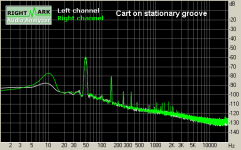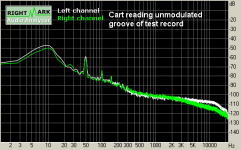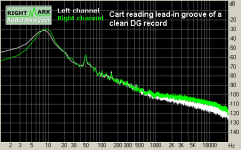If the groove noise is in the noise floor, it must be very poor phono preamplifier design.
Room noise floor ....
Since the phono noise is uncorrelated with room noise, it can be readily audible even below the room noise floor. Masking doesn't help for uncorrelated signals.
Do a simple exercise: a good MC cart will have -65dB SNR (ideally) with respect to nominal output level. Run that through 70dB of phono stage gain, another 26dB of power amp gain, then calculate the SPL from the speakers. Add in another 10-20dB for record surface noise and recalculate.
And since you've offered no evidence that "44dB" is actually a normal room noise for listening rooms, get some data on that as well. As I previously wrote in this thread, I've done the experiment, no need to wave hands.
Do a simple exercise: a good MC cart will have -65dB SNR (ideally) with respect to nominal output level. Run that through 70dB of phono stage gain, another 26dB of power amp gain, then calculate the SPL from the speakers. Add in another 10-20dB for record surface noise and recalculate.
And since you've offered no evidence that "44dB" is actually a normal room noise for listening rooms, get some data on that as well. As I previously wrote in this thread, I've done the experiment, no need to wave hands.
Usually, I don't hear background noise in the electronics, but sometimes I hear the goove noise when playing a record. Guess what, Jack Bybee showed me a way to REMOVE VIRTUALLY ALL the groove noise with a simple quantum part in the input. I will try it at home, soon, but it really works! He did an A-B on his system where the electronics is comparable with mine.
These statements of physical impossibility certainly lower your esteem in my eyes. There is so much good engineering to do.
I will join Werner Herzog and offer to eat my shoe at Chez Panisse if this ever proved possible, gimme a break this is Nobel prize material.
EDIT - not the ones I'm wearing now. SY - Sorry, I found the thread from a year ago where you had explained correctly how to equalize a strain gauge cart. Funny two folks in that thread didn't notice and one got the correction all wrong and of course the manus keep saying they don't.
Last edited:
Well, I was there, at Jack Bybee's house when he made a before-after addition to the input of my Vendetta Research SCP-2, and the groove noise virtually disappeared! What can I say? That it didn't disappear? My associate heard it too, and he does not believe in much. Now, I have a pair of these devices that Jack made, but they need connectors attached, etc, before I can try it myself in my own room. We shall see, if I can duplicate this 'improvement' independently.
A filter can remove noise, but it will also remove signal at the same frequency. To remove wideband noise while leaving the wideband signal untouched you need intelligence: either a human doing computer-aided post-processing or a device containing a Maxwell demon. If done in real-time it must be the latter. The only other explanation is that it didn't do what it appeared to do i.e. you (and he?) were fooled.
Since the phono noise is uncorrelated with room noise, it can be readily audible even below the room noise floor. Masking doesn't help for uncorrelated signals.
Do a simple exercise: a good MC cart will have -65dB SNR (ideally) with respect to nominal output level. Run that through 70dB of phono stage gain, another 26dB of power amp gain, then calculate the SPL from the speakers. Add in another 10-20dB for record surface noise and recalculate.
And since you've offered no evidence that "44dB" is actually a normal room noise for listening rooms, get some data on that as well. As I previously wrote in this thread, I've done the experiment, no need to wave hands.
There is enuff printed material on the subject, I'm sure your capable of doing the research yourself on the typical home noise level, your response does shout you have not done the research or if you did , it was plagued with errors.
Here i will help you out, it's not in braille , sorry .... 🙂
http://www.sengpielaudio.com/TableOfSoundPressureLevels.htm
A very quite room is 40-44, I have measured enuff rooms to know the typical good hi-fi room is 40-44 db , the typical room is 50-54 db, only professional sound rooms and studios get down to 30db ..
Let me know when you catch up ..
Last edited:
A filter can remove noise, but it will also remove signal at the same frequency. To remove wideband noise while leaving the wideband signal untouched you need intelligence: either a human doing computer-aided post-processing or a device containing a Maxwell demon. If done in real-time it must be the latter. The only other explanation is that it didn't do what it appeared to do i.e. you (and he?) were fooled.
Being passive they would create information with no expense of energy and so also violate first principles.
John is not a fool Scott, I'm sure he heard what he said he heard or thought he heard, condemnation without investigation is prejudice, one should give it a listen before calling him on it, he did say he will investigate for sure in his setup.
There is enuff printed material on the subject, I'm sure your capable of doing the research yourself on the typical home noise level, your response does shout you have not done the research or if you did , it was plagued with errors.
OK, so you haven't bothered to do the analysis. And you maintain that Ed Simon is a liar. You believe that nothing can be heard below a noise floor. And the noise I can hear in my room from phono systems is imaginary. Gotcha.
Unfortunately thermodynamics is quite cruel: even highly-respected audio gurus with significant sales are subject to it. John, as a physics graduate, should know this.a.wayne said:John is not a fool Scott, I'm sure he heard what he said he heard or thought he heard, condemnation without investigation is prejudice, one should give it a listen before calling him on it, he did say he will investigate for sure in his setup.
Believing in thermodynamics is not prejudice. Dismissing it on the grounds of who said so is prejudice.
OK, so you haven't bothered to do the analysis. And you maintain that Ed Simon is a liar. You believe that nothing can be heard below a noise floor. And the noise I can hear in my room from phono systems is imaginary. Gotcha.
Putting words in my mouth , you should read more or actually measure your listening space, try it, actual data , I know , unusual for you unless Mr Simon says it's so .......🙄
Thanks Wayne, but discussion about Bybee on this thread is pointless. I'm sorry that I ever mentioned it. Perhaps we should go back to comparing IC based audio with discrete based audio. '-)
Masking doesn't help for uncorrelated signals.
ROTFL!!! 🙂 Otherwise we actually agree on a bit.
A filter can remove noise, but it will also remove signal at the same frequency. To remove wideband noise while leaving the wideband signal untouched you need intelligence: either a human doing computer-aided post-processing or a device containing a Maxwell demon. If done in real-time it must be the latter. The only other explanation is that it didn't do what it appeared to do i.e. you (and he?) were fooled.
What makes you think the device is a filter? There are other approaches to reducing noise that are effective if you look at how the human auditory perception system works. These pop up with great regularity and some are in widespread use.
Now if you want to object to the word quantum....
Last edited:
What is the S/N of your phono system, SY? Can you give me the equivalent noise resistance?
You've read the article and even had some (relatively) complimentary things to say.
Groove noise:
Don’t pay attention on 50, 150, 250, 350 Hz peaks (it is a ground loop issue) but see the noise profile.
The quantum demons have to work hard mostly below 1kHz to clean up the record noise
Mr. Curl
When you will be ready, please make a groove noise recording before and after installing these devices and study the spectrum.
George
Don’t pay attention on 50, 150, 250, 350 Hz peaks (it is a ground loop issue) but see the noise profile.
The quantum demons have to work hard mostly below 1kHz to clean up the record noise
Well, I was there, at Jack Bybee's house when he made a before-after addition to the input of my Vendetta Research SCP-2, and the groove noise virtually disappeared! What can I say? That it didn't disappear? My associate heard it too, and he does not believe in much. Now, I have a pair of these devices that Jack made, but they need connectors attached, etc, before I can try it myself in my own room. We shall see, if I can duplicate this 'improvement' independently.
Mr. Curl
When you will be ready, please make a groove noise recording before and after installing these devices and study the spectrum.
George
Attachments
You've read the article and even had some (relatively) complimentary things to say.
link.....
Just for giggles I measured the A weighted noise at home. It is 26 dB. But it does rise to 33 dB when a car goes by. My eating a salad gets up to 38 dB. I like the crunchy stuff. My standard is a Bruel and Kjaer piston phone. Accuracy is better than 1 dB for the system.
- Status
- Not open for further replies.
- Home
- Member Areas
- The Lounge
- John Curl's Blowtorch preamplifier part II




